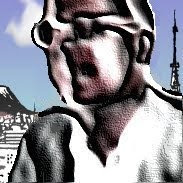 1) Ginger and the 'Voice Recording Booth'
1) Ginger and the 'Voice Recording Booth'Here's a lovely Ginger strip a from a very early Beezer (1956 - its first year) drawn by Dudley Watkins. In this story Ginger has been persistently kicking his football over his neighbour's fence. Aflter one too many scoldings he loses his nerve and has to resort to recording his voice in order to ask for his ball back. We see Ginger going to a recording booth in order to record his message
In the 1950s the only way many people could record their own voice was to use a voice recording machine which actually transferred your voice onto a record.
 In those days your recording couldn't last any longer than two minutes and voices were laid down on a six-inch cardboard record that could then be played at home. Alot of real-life recording artists started out this way including a certain young singer called Elvis Presley.
In those days your recording couldn't last any longer than two minutes and voices were laid down on a six-inch cardboard record that could then be played at home. Alot of real-life recording artists started out this way including a certain young singer called Elvis Presley.
The Voice-O-Graph was the most widley used record recording booth. It was similar to a photo booth and let the patron make an actual 6" record which could be played on any record player.
Links:
Remembering Recording Booths
1957 Multoscope Voice-O-Graph
Production of gramaphone records


2 comments:
in common with ELVIS, the BEATLES also recorded their earliest material using a shop method similar to this: [though they were probably still known as the Quarrymen back in the late 50s].
RAB SMITH.
Apna Showroom Metal Hairband and Hair Rose Pin Clip—an elegant addition to any wardrobe. Perfect for men and women who want a durable, stylish hair accessory for everyday or formal occasions.
APNA SHOWROOM Bra for Women Combo Pack of 6 - Cup Size 36(B) Non-Wired Multicolor Everyday Cotton Bra 36B
APNA SHOWROOM Bra for Women Combo Pack of 6 - Cup Size 32(B) Non-Wired Multicolor Everyday Cotton Bra 32B
APNA SHOWROOM Bra for Women Combo Pack of 6 - Cup Size 34(B) Non-Wired Multicolor Everyday Cotton Bra 34B
Enhance your hairstyle effortlessly with Apna Showroom’s Metal Hairband and Hair Rose Pin Clip. Built for durability and elegance, it’s perfect for men and women looking for a unique touch.
Post a Comment